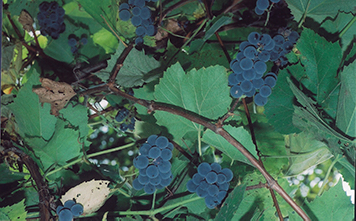Symbolism of the Grape Vine
“Remaining” in Christ is The Sturdy Root of Discipleship
 The image of an old, carefully pruned grapevine portrays strength to me. I have seen such a gnarled grapevine planted near the Milwaukee motherhouse in Elm Grove, Wisconsin. The American foundress of the School Sisters of Notre Dame, Mother Caroline Freiss, requested that a grape arbor be planted there in 1886 just six years before her death in 1892. And the grapevine she had planted continues to grow.
The image of an old, carefully pruned grapevine portrays strength to me. I have seen such a gnarled grapevine planted near the Milwaukee motherhouse in Elm Grove, Wisconsin. The American foundress of the School Sisters of Notre Dame, Mother Caroline Freiss, requested that a grape arbor be planted there in 1886 just six years before her death in 1892. And the grapevine she had planted continues to grow.
The courage of my sisters, their ability to dialogue in difficult situations, their good humor and resiliency – all have inspired me. Often a strong reliance on Mary, the Mother of God, had a major impact on their decisions. Peaceful solutions were followed by deep praise of Christ, celebrating their Magnificat moments.
The roots of this vine in Elm Grove are sturdy and deep and have been carefully tended by the sisters for more than one hundred years. However, in the last years of the 20th century, the vine produced lovely shade but no edible grapes. Rick, a new gardener, began tending the vine. He pruned it drastically, cutting it back to almost nothing. A year later it produced an abundance of Concord grapes that the sisters used to provide good jam and 30 gallons of fine wine. And the grapes keep coming.
In Jesus!
I write this now in Jesus who has shown me indescribable mercy and shared with me his poverty, hardships, suffering, anxiety, and need! I cannot describe my interior peace. Now I am in Jesus! Jesus may do what he wants with me; I trust in him. ”Remain in me, as I remain in you.” (John 15:4) On him, I will build… I know I cannot cater to my body; my soul must also be purified. I entrust this purification to the Vinedresser who will strip the branches and prune them, a purification which will probably be painful. Therefore, everything is only by the grace of God, the merits of Christ, and the intercession of his Blessed Mother.
Amen.1
This image of being “in Jesus” is found in the Gospel of John forty times, making “remaining” in Christ the “sturdy root” of discipleship. This desire to remain in Jesus is central to understanding the spirituality of Mother Theresa and the School Sisters of Notre Dame. “I am the true vine and my Father is the vinedresser. Every branch in me that bears no fruit he cuts away, and every branch that does bear fruit he prunes to make it bear even more. You are pruned already by means of the word that I have spoken to you. Make your home in me, as I make mine in you. As a branch cannot bear fruit all by itself, but must remain part of the vine, neither can you unless you remain in me.” John 15:1-4.
These words of Jesus continue to guide the School Sisters of Notre Dame. As the community continues to live, grow, and be transplanted into various soils and cultures, one sees evidence of the metaphor of the vine and branches being lived out. Because the congregation is a living organism, it cannot be neatly packaged and finished. Like a grapevine, it is constantly being pruned, cut back, tied to a structure that often restrains it and, as the same time, fosters growth. It seems that some of the greatest moments in this story are those in which “pruning” was/is accepted. During such time the congregation found a deeper story in which to “remain” in the Vine/Christ, to trust that the loss and pain would bear fruit at some future time.
As “remaining in Christ” leads to discipleship and a desire to imitate Mary, the first disciple, we pray to be drawn into the truth expressed in the motto of the School Sisters of Notre Dame: “All the works of God proceed slowly and in pain; but then, their roots are sturdier and their flowering the lovelier.” (Blessed Mother Theresa of Jesus Gerhardinger)
Footnotes:
- Letters of Mother Theresa Gerhardinger, SSND, March 16, 1822, Trans. Mary Ann Kuttner, SSND.